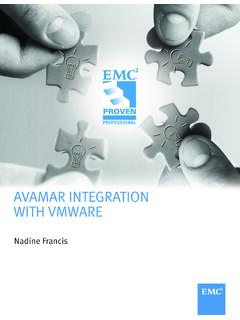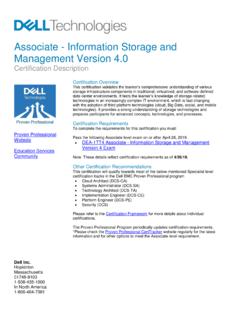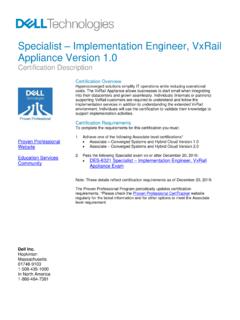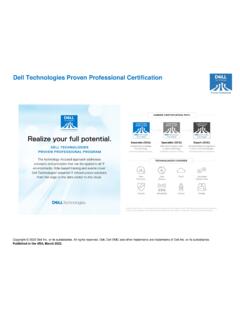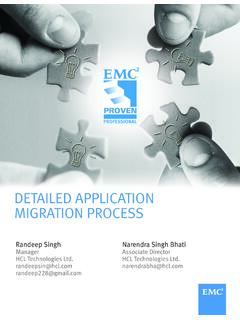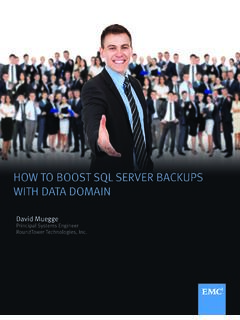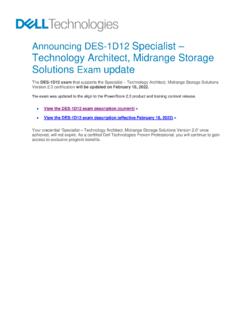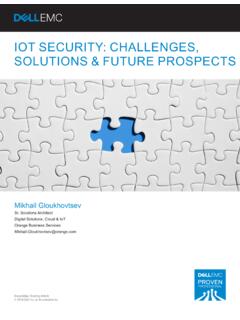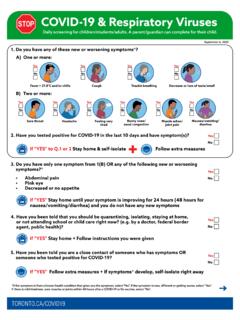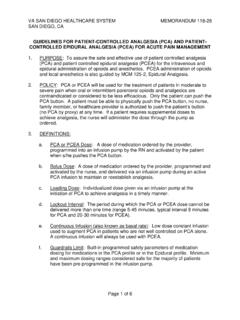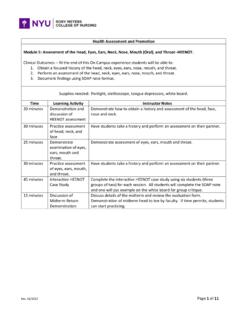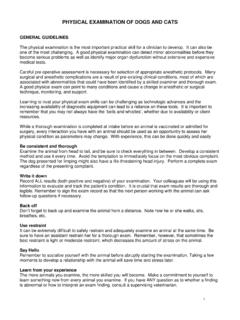Transcription of THE IT MANAGED SERVICES TRANSITION PROCESS
1 THE IT MANAGED SERVICES TRANSITION PROCESSC harles WeeksAdvisory Delivery SpecialistDell Sharing Article 2018 Dell Inc. or its subsidiaries. 2018 Dell EMC Proven Professional Knowledge Sharing 2 Table of Contents Introduction .. 3 The 3 Phases of an IT MS TRANSITION .. 3 Discovery Phase .. 3 Access to the Environment .. 3 Discovery of the Environment .. 3 Creating an Activity Matrix .. 4 Attending Operational Meetings .. 4 Developing a Gap Analysis .. 4 Assessment Phase .. 4 Operational Integration Phase .. 5 Conclusion .. 5 Disclaimer: The views, processes or methodologies published in this article are those of the author. They do not necessarily reflect Dell EMC s views, processes or methodologies. 2018 Dell EMC Proven Professional Knowledge Sharing 3 Introduction In any IT MANAGED SERVICES (MS) organization, the ability to successfully " TRANSITION " new accounts into a "steady state" operation is vital.
2 The term, "transitioning", applies to a set of activities that an MS Team must employ to enter into a newly acquired IT environment and take over its operations. This type of engagement usually encompasses 90 days from "kickoff" to "go live". In that period, several tasks must take place, from obtaining environment access and identifying gaps , to documenting the environment for the incoming support team. The success of the TRANSITION engagement depends upon an MS group s ability to follow a methodology of activities and tasks that, if worked successfully, produce an operations team that is prepared to "go live" and take over a customer s IT operations. After participating in several IT TRANSITION projects it is possible to organize and document a methodology around the TRANSITION task. This article describes the steps and activities essential to attain a successful IT MS TRANSITION . The 3 Phases of an IT MS TRANSITION Through experience, it s been established that successful MS transitions follow a 3-phase structure; Discovery, Assessment, and Operational Integration.
3 Each phase has its own unique tasks and objectives to meet for the TRANSITION PROCESS . Discovery Phase The discovery phase is a set of tasks designed to provide a base of operations for the team. Access to the Environment Obtaining access to the environment is the foundation of a TRANSITION . It s often the most time- consuming aspect of a project. No other TRANSITION work can be performed without access. The PROCESS should be started as soon as possible. First, the team must have a physical or virtual method of contacting the account s environment. This is accomplished by either providing physical equipment (laptops) or virtual access (Citrix, jump box) to the team. The team will also need accounts for managing business as usual (BAU) operations. Email, ticketing system (ServiceNow, HP Service Manager), authentication UIDs (LDAP, AD), and service management IDs used to run infrastructure equipment (backup, storage, and switch systems) must be created.
4 Most, if not all, MS team accounts will require high privilege access (HPA). Obtaining these accounts will require following an account s security PROCESS . Discovery of the Environment Once the team has access, they can begin surveying the environment. The equipment, tools and processes that are present need to be located and documented. If they are available, this can be accomplished by using a customer s existing asset lists and standard operating procedure (SOP) documents. 2018 Dell EMC Proven Professional Knowledge Sharing 4 However, it is not uncommon to find an account that has been running an environment without documented processes and using informal or tribal knowledge methods of operating. If this is the case, SOP documentation needs should be identified and a development plan put in place ASAP. Creating an Activity Matrix With the knowledge gained from access and discovery, building of an activity matrix can begin.
5 An activity matrix is a chart of tasks performed to manage an environment. The tasks involve everything from system power up/down to upgrades and decommissions. The matrix will also list the technical staff level (Level 1, 2, or 3) required for each task. The matrix is a roadmap for BAU operations (what gets done by whom and when). Attending Operational Meetings Operational meetings are sources of formal and informal information in the account s environment. These meetings will reveal the leaders, operational PROCESS flow (especially if an account uses ITIL principles), and pain points (system malfunctions, capacity issues) existing in an environment. Developing a Gap Analysis All TRANSITION projects will have gaps of some kind. Gaps are differences between the current operations of an environment and established best practices, as well as informal processes of the customer versus formal activities documented in the account contract.
6 Gaps can also involve pain points that the customer wants to address during the TRANSITION PROCESS . Examples can be equipment that is no longer supported or operational functions that do not have any SOPs associated with them. The Gap Analysis is the final step in the discovery PROCESS . It s a report that identifies what needs to be learned, documented, and MANAGED in the environment. It s important that the analysis be thorough so that the account contract team can set expectations of the level of service at go live and also have a plan for closing the gaps through knowledge, training, and maintenance. Assessment Phase The assessment phase is where the team takes the knowledge and materials obtained through the discovery phase and organizes them into documentation and processes that will be used by the operations staff. Standard Operating Procedures (SOPs) A goal of every MS Team is to have an SOP associated with every action or change performed in an environment.
7 SOPs provide a repeatable template for performing an operation. Some accounts will require an SOP for any change occurring in the environment. If there s existing SOP documentation, it s important that it s validated. It s not uncommon to find out of date and incorrect customer SOP data. The team will need to decide if existing SOP documentation is useful or if new SOPs need to be developed. If tasks and processes have no SOPs, it s important that they are declared as gaps and a plan to develop the documentation be stated in the Gap Analysis. 2018 Dell EMC Proven Professional Knowledge Sharing 5 Training Materials and Runbook Authoring The operational team will need training to perform daily tasks. For accounts using ITIL principles, this will involve learning the customer s ticketing system (ServiceNow, HP Service Manager). The team will also need to understand the account s Service Level Agreements (SLAs) and Key Performance Indicators (KPIs).
8 Protocols, procedures, and communications relating to emergencies and major outages will also need to be covered by the team. At the end of this PROCESS a Runbook is created that contains all of the above information. The Runbook is what will be used to train new team members and can also be used during account service auditing processes. Operational Integration Phase Operational Integration is the final TRANSITION phase. It is where the team is prepared to take over the account s environment. The individuals present in this phase will make up the production or steady state team post go live. Shadowing and Reverse Shadowing Sessions Shadowing is the PROCESS of observing the work of an experienced staff member. This task is normally accomplished via a virtual (WebEx) session. An individual will walk through the aspects of their job during a 1 to 2 hour period. Shadowed tasks can involve managing tickets, providing data restores, or provisioning storage.
9 It is a demonstration of how a job is performed. At some point prior to go live, the shadowing will be reversed. During reverse shadowing, the steady state team members perform the processes to demonstrate their ability to take over an assigned job. Delivery Assurance (DA) DA is an activity where a set of operational scripts (ticket management, backups, restores, storage provisioning) are presented to the steady state team to demonstrate the team s preparedness to manage the environment. The output of the DA PROCESS is a report that specifies that members of the steady state team have proven the ability to perform the contracted operational tasks. Completing Account Deliverables This task involves completing any infrastructure (equipment or software) installs that are part of the contract and delivering any required operational Runbooks or documentation. Conclusion Go Live is the date and time when an account s environment is officially handed over to the MS steady state team.
10 Each account and contract has its unique challenges. Hopefully, this article has described a PROCESS framework that can be applied to any IT MS TRANSITION project and help it to be a success. 2018 Dell EMC Proven Professional Knowledge Sharing 6 Dell EMC believes the information in this publication is accurate as of its publication date. The information is subject to change without notice. THE INFORMATION IN THIS PUBLICATION IS PROVIDED AS IS. DELL EMC MAKES NO RESPRESENTATIONS OR WARRANTIES OF ANY KIND WITH RESPECT TO THE INFORMATION IN THIS PUBLICATION, AND SPECIFICALLY DISCLAIMS IMPLIED WARRANTIES OF MERCHANTABILITY OR FITNESS FOR A PARTICULAR PURPOSE. Use, copying and distribution of any Dell EMC software described in this publication requires an applicable software license. Dell, EMC and other trademarks are trademarks of Dell Inc. or its subsidiaries.
